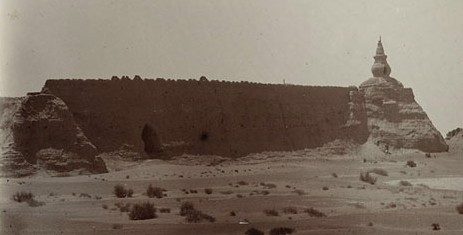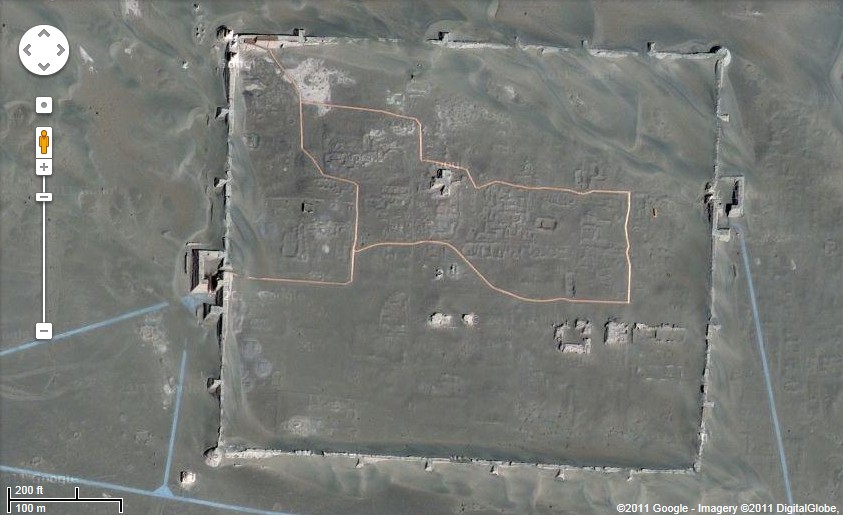BabelStone Blog
Wednesday, 26 October 2011
Fragments from a Dead City
[This is a revised version of a blog post that I first published on 7 February 2007, but which I later deleted for unknown reasons. I was reminded of it by my recent blog post on a fragment of a Khitan manuscript, and so am republishing it today.]
The remains of the Tangut fortress city known in Mongolian as Kharakhoto "Black City" and in Chinese as Heishuicheng 黑水城 "Black Water City" are located on the edge of the Gobi desert in the far west of Inner Mongolia (41° 45′ 51.50″N, 101° 08′ 38.00″E). It was a major military outpost of the Western Xia regime until it was captured by Genghis Khan in 1226. The city remained under Mongolian control until it was taken by the army of the newly established Ming dynasty in 1372, after which it was abandoned.
Photograph of the Ruins of the city of Kharakhoto by Aurel Stein
Kharakhoto from the sky (cf. Stein's plan of Kharakhoto)
When the Russian explorer Pyotr Kozlov stumbled upon the ruins of the city in 1907–1909 he found hundreds of books and documents written in the Tangut script, mostly hidden inside a stupa, including such important works as the Tangut dictionary, the Sea of Characters (文海).
But by the time that Aurel Stein came to visit Kharakhoto during his expedition of 1913-1916 there was not much left, and he was reduced to searching through rubbish tips and looking down wells. Although he didn't find any complete Tangut texts such as Kozlov had, he did manage to recover a great number of fragmentary scraps of paper with Tangut writing, some 4,000 of which are now held at the British Library (enter "Kharakhoto" in the search box to see some examples).
Among the scraps of paper that Aurel Stein recovered from a rubbish tip in the ruins of Kharakhoto are two insignificant and rather uninspiring strips of paper covered with irregular black marks which are now held at the British Library, catalogued as Or.8212/1142 and Or.8212/1144 :
By themselves they do not seem to have very much to offer, but when you join the two fragments together (Or.8212/1144 on the left, and Or.8212/1142 on the right) the black marks magically resolve into a relatively clear line of Phags-pa text :

It is not very much, but it is the only certain example of the Phags-pa script that I have been able to find in the entire online collection of the International Dunhuang Project (there are other more impressive examples of Phags-pa manuscripts, and even a fragment of a printed text, in the Berlin Turfan Collection, but these are not yet in the IDP database). Incidentally, although there is such a paucity of Phags-pa material in the British Library's Dunhuang collection, the library does hold the only known copy of what I would argue is the single most important Phags-pa text in existence, the Phags-pa Chinese rhyming dictionary Měnggǔ Zìyùn 蒙古字韻 (Or. 6972).
The top lefthand edge of the joined strips is still cut off, and I have been unable to locate a matching strip of paper in the British Library collection. However, even with this defect the text is still perfectly legible, comprising four Phags-pa syllables, reading ti khung ·an tu ꡈꡞ ꡁꡟꡃ ꡖꡋ ꡈꡟ :

According to Měnggǔ Zìyùn, there are 49 Chinese characters that are spelt ti, 12 characters that are spelt khung, 4 characters that are spelt ·an, and 38 characters that are spelt tu (the Phags-pa script does not distinguish tone, so Měnggǔ Zìyùn separates Chinese characters with the same Phags-pa spelling into groups based on their tone in Classical Chinese: level tone [平聲], rising tone [上聲], falling tone [去聲], and entering tone [入聲]) :
| ꡈꡞ | ti | Level tone characters: 嗁啼遆蹄折提題媞綈稊醍禔鵜荑緹騠 |
| Rising tone characters: 弟娣悌遞 | ||
| Falling tone characters: 弟第遰提髢締{⿰目帝}(!)悌娣禘棣杕踶題遞逮地 | ||
| Entering tone characters: 狄荻敵籊翟覿笛籴糴滌踧頔 | ||
| ꡁꡟꡃ | khung | Level tone characters: 空箜崆悾倥(倥侗颛蒙) |
| Rising tone characters: 孔倥悾 | ||
| Falling tone characters: 控倥空鞚 | ||
| ꡖꡋ | ·an | Level tone characters: 安鞌 |
| Falling tone characters: 按案 | ||
| ꡈꡟ | tu | Level tone characters: 徒屠瘏塗途酴駼荼圖菟(?) |
| Rising tone characters: 杜肚土 | ||
| Falling tone characters: 渡斁鍍度 | ||
| Entering tone characters: 獨讀黷讟髑殰櫝牘韥瓄瀆犢匵毒蝳宊揬纛腯堗鈯 |
This would theoretically give 49 × 12 × 4 × 38 = 89,376 possibilties for the four-syllable phrase ti khung ·an tu, but actually there is only one permutation that makes any real sense in this context: tí kòng àn dú 提控案牘, which is the title of a minor official in charge of official documents at the local government office during the Yuan dynasty (see Charles O. Hucker, A Dictionary of Official Titles in Imperial China (Stanford University Press, 1985) #6453: "tʼí-kʼùng àn-tú 提控案牘 or tʼí-kʼùng YÜAN: lit., in charge of files: Record Keeper, a lowly or unranked clerical worker commonly found in both central government agencies and units of territorial administration"). The lettering appears to be printed on the paper rather than handwritten, so this was perhaps a stamp that was used by this official sometime during the Mongolian occupation of Kharakhoto between 1226 and 1372 (though of course it must post-date the invention of the Phags-pa script in 1269).
Index of BabelStone Blog Posts



